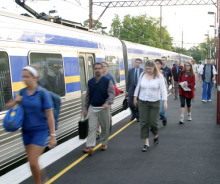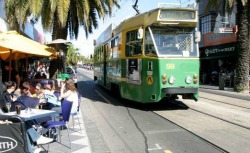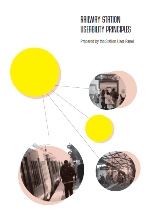Public transport

Walking is the primary means of accessing public transport. In Melbourne:
- 66% of people walk to the train *
- 96% of people access bus services by walking
- 98% of people access tram services by walking
* A further 15% of train access trips include bus or tram journeys, which nearly always involve walking
Source: Walking and transport in Melbourne suburbs
So, to promote public transport is to promote walking. The relationship is mutually beneficial - to achieve optimal use of public transport, high quality walking environments are required around stations and stops.
Public transport users in metropolitan Melbourne average 28 minutes walking to and from public transport each day, plus six minutes walking for other purposes. This is enough to meet the recommended 30 minutes daily exercise for adults.
Car travellers meanwhile average only six minutes in total (Pedestrian Access Strategy 2010).
Public transport systems

Effective public transport planning needs to ensure that all areas are connected by convenient, high frequency, direct public transport. This should be a genuine alternative to car travel for everyone. In Melbourne there seems to be a level of consensus that this should be based primarily on much better bus services, connecting to a slightly extended train and tram network.
Where traffic congestion is an issue, public transport will need to be afforded active priority over private vehicles. Trunk transit services need to be planned to stay ahead of demand - not a rolling response to chronic overcrowding. Public transport planning should encourage walking to transit rather than facilitating park and ride.
Major public transport initiatives have a range of positive socio-economic impacts and the potential to be city shaping projects that build a sustainable future. "Major infrastructure projects, especially transport projects... can have a significant influence on the future anatomy of a city, locking in patterns of demand for generations." (NZ National Infrastructure Plan 2010)
Public Transport Victoria's Network Development Plan - Metropolitan Rail sets out a plan for a 21st century rail system in Melbourne. Some say it is too ambitious, but it could easily be achieved if there is a reorientation of transport spending from freeways to public transport.
The Public Transport User Association report Connecting to the Future provides an interesting alternate perspective on Melbourne's transport needs.
Public transport interchange design

Pedestrian oriented design is particularly critical around public transport stops and interchanges, where high volumes of pedestrians can be expected. Unfortunately, even the most basic elements of walkability are often missing. A study of bus stops in outer Melbourne found more than 1,600 (18%) were not connected to the footpath network (RACV 2009).
The Station User Panel (2011-2012) included Victoria Walks and was established by the Department of Transport to advise on train station development and redevelopment projects. The Panel developed Railway Station Useability Principles to better reflect the expectations of users and communities in the operation and development of stations, and enhance the places in which they are located.